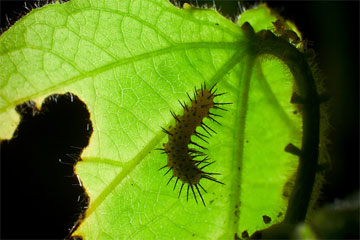Insect diversity in rainforests results from plant biodiversity
 Owl butterfly in Peru. Photo by Rhett A. Butler. |
Insect diversity in rainforests results from plant biodiversity
mongabay.com
July 18, 2006
The high diversity of leaf-eating insect species in tropical forests results from the large number of plant species that exist in these ecosystems, according to new research published in the current issue of the journal Science.
“Understanding the drivers of the high diversity in tropical forests has been a major question since Darwin and Wallace visited tropical forests — and even before,” wrote co-author Scott Miller of the Smithsonian National Museum
of Natural History in Washington, “We found that higher tropical tree diversity explains why there are more leaf-eating insects in tropical than in temperate forests.”
While it may seem obvious that “forests with greater numbers of tree species should support a wider variety of leaf-eating insects than do less diverse forests… no one had ever done the experiment to rule out the major alternative explanation: that insect species in the tropics eat the leaves of a smaller number of host trees (are more host specific), which would also result in more insect species in a given area,” explained a release from the Smithsonian.
The study provides the best experimental evidence to date to account for the higher level of herbivorous insect biodiversity in tropical regions.
 Photo by Marcos Guerra, STRI. |
After collecting 850 species of leaf-eating insects from 14 tree species in forest sites in Central Europe and Papua New Guinea and conducting feeding trials, the international team of researchers concluded that since (1) individual temperate and tropical tree species support similar numbers of leaf-eating insects and (2) the number of different plant species upon which a single species of insect feeds did not differ significantly between temperate and tropical communities, “the greater number of tree species in the tropics is the best explanation for higher insect diversity.”
Insects are by far the most diverse and abundant animals in tropical forests — studies have found that a single square mile of rainforest often houses more than 50,000 insect species. Researchers say that of the estimated 5-10 million insect species on Earth, only about 2 million have been identified.
The Smithsonian release notes that since “nearly nothing is known about the behavior or environmental impact of most insect species… the conclusion that tree diversity drives insect diversity is a great step forward in the understanding of life on earth.”
This article used information and quotes from an Smithsonian Tropical Research Institute news release.
Insects worth $57 billion to US economy A new study says insects are worth at least $57 billion to the American economy. In the April 2006 issue of BioScience, John E. Losey of Cornell University and Mace Vaughan of the Xerces Society for Invertebrate Conservation estimate the value of ecological services provided by insects. Looking at just four services–dung burial, control of crop pests, pollination, and wildlife nutrition–Losey and Vaughan calculate that the annual value of insects in these roles is at least $57 billion in the United States. $50 billion of this amount comes from the value of insects in sustaining hunting, fish, and other nature-oriented activities, while $4.5 billion is attributed to natural pest control and at least $3 billion is from pollination. The authors cite dung beetles as an example of an insect that brings tangible benefits to humankind in that they “reduce the effects of parasites and pests on cattle, enhance the palatability of forage to cattle, and make nitrogen in dung more readily available to plants.”